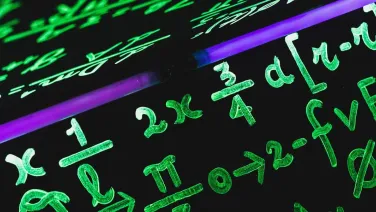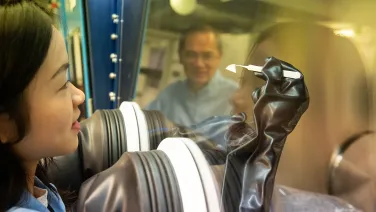Digging a tunnel in a quantum field

When Rosemary Zielinski was offered an honours project to develop a theory of quantum tunnelling, her first thought was, 'but that’s already done – I studied that in second year!'
Quantum tunnelling is a well-documented example of quantum weirdness; particles that, according to Newton’s Laws, should (because, for example, like charges repel) never have the energy to get through barriers, over potential hills and into close proximity, do so.
The result is fusion in stars creating the carbon we’re made of, α-decay heating the earth’s interior and DNA mutations in our cells. And we have put it to use in tunnelling electron microscopes, FLASH memory and tunnel junctions in solar cells.
So imagine Ms Zielinski’s surprise when her supervisor-to-be, Professor Cedric Simenel, informed her that quantum theory’s treatment of tunnelling was incomplete: it does not employ quantum field theory which is more complete and accurate than traditional quantum mechanics.
"Quantum mechanics assumes a particle tunnelling through a barrier is free of interactions with other particles, but there is no such thing," says Professor Simenel, the head of the Department of Fundamental and Theoretical Physics.
Quantum Field Theory says there are particles popping in and out of the vacuum, which the tunnelling particle will interact with, and that could change the probability of tunnelling.
"But we don’t know yet how big this effect is: quantum mechanics could be significantly wrong!"
It’s pretty ambitious for an honours project – and no, Ms Zielinski didn’t develop a complete theory. But she took the first step, to work out how to approach the problem, and work out the equations that need to be solved.
"And now we‘ve realised why it is so difficult – there are no general solutions for these equations," Ms Zielinski said.
"But it was immensely fun."
Ms Zielinski completed her honours in the Fundamental and Theoretical Physics department, earning a University Medal.
The project sprang from an offhand comment from her supervisor-to-be, Professor Cedric Simenel, who was listing various honours topics that he was offering.
"And then he mentioned this topic, and pointed out that it won’t be well defined, you’ll be taking a bit of a risk. And immediately I was drawn to it!" Ms Zielinski said.
Professor Simenel was inspired to think about the problem by recent measurements by his colleagues in the Department of Nuclear Physics and Accelerator Applications, who revealed complicated behaviour when nuclei fuse, or nearly fuse, which no one consistent theory has managed to describe accurately.
The challenge is that in fusion, the particle tunnelling through the barrier is not a simple single quantum object, but a compound nucleus, made of many quarks within nucleons – far beyond the scope of conventional quantum mechanics.
It is this tunnelling process by which helium atoms fuse to form carbon in stars: the work that Ms Zielinski has begun could be the first step towards understanding how the carbon that we are all made of came into existence.
There is much work before that goal is achieved. As few people have thought about this problem the literature was scarce, and the problem was non-perturbative, meaning that the problem can’t be solved by tweaking existing equations - entirely new ones need to be developed.
Ms Zielinksi’s early analytical results with simplistic situations, for example neutral scalar fields and a simple barrier, showed that approach is sound – but the equations are self-referential, which makes them hard to solve.
The complexity of the problem delights Ms Zielinski.
"It’s exciting that it’s a little bit subversive. We physicists think we understand tunnelling well, but when you take a closer look, there are a lot of paradoxes – there’s so much more behind it. You have to re-learn something you thought you knew."
This article was first published by ANU Research School of Physics.



